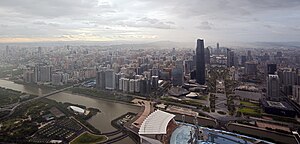Zhujiang New Town
This article needs additional citations for verification. (May 2018) |
| Zhujiang New Town | |||||||||||
|---|---|---|---|---|---|---|---|---|---|---|---|
 New Town at dusk | |||||||||||
| Simplified Chinese | 珠江新城 | ||||||||||
| Literal meaning | Pearl River New City | ||||||||||
| |||||||||||
Zhujiang New Town or Zhujiang New City is an area in Guangzhou, Guangdong, China. It is bounded by Huangpu Avenue on the north, the Pearl River on the south, Guangzhou Avenue on the west and the South China Expressway on the east.
Covering an area of 6.44 km2, the area is divided by Xiancun Road (Chinese: 冼村路) into two parts. The larger eastern part contains mainly high-end residential complexes and the Zhujiang Park, which lies at the centre. Such a layout was modelled on the Central Park in New York where the park itself provides a green oasis in the city centre and increases the value of surrounding properties.
The western portion of Zhujiang New Town was planned as the city's new CBD for the 21st century. Its core area, which the government designated as the city's new axis of development, is a continuous open plaza which extends approximately 1.5 km from Huangpu Avenue to the Pearl River. The plaze incorporates underground shopping malls, vehicular tunnels and a people mover system. Flanked by skyscrapers, at its southern end it hosts four newly built cultural venues of the city: the Guangzhou Opera House, the second Children's Palace, the new Guangzhou Library and Guangdong Museum. Immediately to the north of these buildings are the supertall Twin Towers and across the river stands the Canton Tower, which is the tallest structure in Guangzhou.
While planning of Zhujiang New Town began as early as in the late 1980s, development had stagnated for more than a decade. To encourage development, the local government relocated some of its departments to the area, including the customs office[1][2][3] and the taxation bureau. A piece of land measuring about 3 hectares was specifically reserved and sold to the U.S. Consulate. Private companies however, were reluctant to move in due to the poor traffic connection and a lack of other amenities at that time. Eventually in 2003 the government carried out a planning review of the area, in which some major adjustments were made to the original plan including more public facilities and transport infrastructure being added to the original plan. The area finally met its opportunity of rapid development as the city prepared to host the 2010 Asian Games. The adjacent Haixinsha island was chosen as the venue of the opening ceremony, as a result the area attracted large investment from the government and property developers. Today Zhujiang New Town has the largest concentration of luxurious hotels and office buildings in the city.
Zhujiang New Town is served by a dedicated people mover system and the Zhujiang New Town station of Guangzhou Metro.
